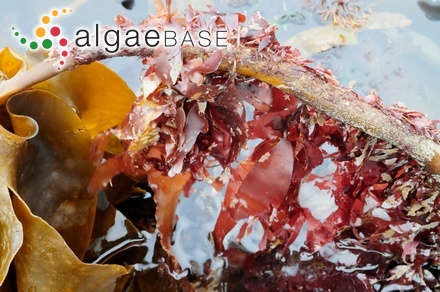Palmaria palmata (Linnaeus) F.Weber & D.Mohr 1805

Current name:
Palmaria palmata (Linnaeus) F.Weber & D.Mohr
Smerwick Harbour, Co. Kerry, Ireland - 12 August 2010. Michael Guiry (mike.guiry@nuigalway.ie)
Publication Details
Palmaria palmata (Linnaeus) F.Weber & D.Mohr 1805: 256, 259, 299, 300
Published in: [Weber, F. & Mohr, D.M.H.] (1805). Einige Worte über unsre bisherigen, hauptsächlich carpologischen Zergliederungen von kryptogamischen Seegewächsen. Beiträge zur Naturkunde 1: 204-329.
Type Species
The type species (lectotype) of the genus Palmaria is Ceramium palmatum (Linnaeus) Stackhouse.
Status of Name
This name is of an entity that is currently accepted taxonomically.
Basionym
Fucus palmatus Linnaeus
Type Information
Type locality: ""Ad oras atlantica""; (Linnaeus 1753: 1162) Lectotype: L; 910.184.2889 (Irvine & Guiry 1983: 68) Notes: Linnaeus's description was taken from Van Royen (1740) and a lectotype has been selected from his herbarium (which Linnaeus examined).
Origin of Species Name
Adjective (Latin), lobed or divided in the manner of an outspread hand with the sinuses between the lobes pointing to the place of attachment (Stearn 1983).
General Environment
This is a marine species.
Description
Reddish brown, membranous or leathery, flattened fronds, 50-300 (-1000) mm long, arising from a discoid base, usually with a small stipe expanding gradually to form simple or dichotomously and palmately divided fronds, often with characteristic marginal leaflets. Blade very variable in shape, having broadly ovate to narrowly linear segments.
Habitat
Marine. On rock, mussels and epiphytic on several algae, intertidal (at all levels but particularly near low water) and shallow subtidal , especially on upper part of Laminaria hyperborea stipes (to a depth of 5 m), widely distributed, abundant. Undivided or sparingly divided forms occur on mussels on exposed shores and sometimes in the subtidal (to 20 m in exceptionally clear water); plants growing on exposed shores, known in Ireland as Creathnach, are considered to be more palatable than the leathery plants of the lower intertidal of semi-exposed shores, which are usually dried and sold as Dillisk or Dilleasc; these forms may ultimately prove to be a separate entity. A very finely dissected form grows epiphytically on rocks, pedbbles and Fucus serrratus in the sheltered parts of semi-exposed shores where silt or fine sand accumulates; this is sometimes known as the "var. sobolifera" or "var. sarniensis" and is much less common than the other forms.
Key Characteristics
The palmate branching with its finger-like extensions is very characterstic; most plants have marginal proliferations at the base. Young plants can be less leathery and may be thin and slippery.
Similar Species
The finely-divided forms are sometimes misidentified as Gracilaria multipartita, the latter is, however, much thicker, and recognisably fleshy.
Created: 30 March 1996 by M.D. Guiry.
Last updated: 06 June 2024
Verification of Data
Users are responsible for verifying the accuracy of information before use, as noted on the website Content page.
Linking to this page: https://www.algaebase.org/search/species/detail/?species_id=1
Citing AlgaeBase
Cite this record as:
Pier Kuipers in Guiry, M.D. & Guiry, G.M. 06 June 2024. AlgaeBase. World-wide electronic publication, National University of Ireland, Galway. https://www.algaebase.org; searched on 03 January 2025
 Request PDF
Request PDF














